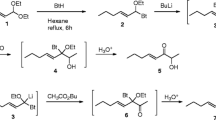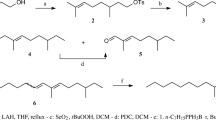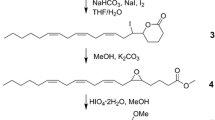Abstract
The sex pheromone of the fir coneworm moth consists of a blend of (3Z,6Z,9Z,12Z,15Z)-pentacosapentaene and (9Z,11E)-tetradecadienyl acetate. Analogous blends of polyunsaturated, long-chain hydrocarbons with much shorter chain aldehydes or alcohols recently have been discovered in three other moth species in the superfamily Pyraloidea. These combinations of components from two distinct structural classes may represent an important and widespread new pheromone blend motif within the Lepidoptera.

Similar content being viewed by others
References
T. Ando S.-I. Inomata M. Yamamoto (2004) Lepidopteran sex pheromones S. Schulz (Eds) The Chemistry of Pheromones and Other Semiochemicals I: Topics in Current Chemistry 239 Springer Berlin, Heidelberg, New York 51–96
A. Cabrera A. E. Eiras G. Gries R. Gries N. Urdaneta B. Miras C. Badji K. Jaffe (2001) ArticleTitleSex pheromone of tomato fruit borer, Neoleucinodes elegantalis J. Chem. Ecol. 27 2097–2107 Occurrence Handle10.1023/A:1012299021967 Occurrence Handle11710613 Occurrence Handle1:CAS:528:DC%2BD3MXotFGrur8%3D
J. A. Coffelt K. W. Vick P. E. Sonnet R. E. Doolittle (1979) ArticleTitleIsolation, identification, and synthesis of a female sex pheromone of the navel orangeworm, Amyelois transitella (Lepidoptera: Pyralidae) J. Chem. Ecol. 5 955–966 Occurrence Handle10.1007/BF00990218 Occurrence Handle1:CAS:528:DyaL3cXhslOks74%3D
S. C. Jain D. E. Dussourd W. E. Conner T. Eisner A. Guerrero J. Meinwald (1983) ArticleTitlePolyene pheromone components from an arctiid moth (Utetheisa ornatrix): Characterization and synthesis J. Org. Chem. 48 2266–2270 Occurrence Handle1:CAS:528:DyaL3sXkt1aitL0%3D
R. Jurenka (2004) Insect pheromone biosynthesis S. Schulz (Eds) The Chemistry of Pheromones and Other Semiochemicals I: Topics in Current Chemistry 239 Springer Berlin, Heidelberg, New York 97–131
W. S. Leal A. L. Parra-Pedrazzoli K.-E. Kaissling T. I. Morgan F. G. Zalom D. J. Pesak E. A. Dundulis C. S. Burks B. S. Higbee (2005) ArticleTitleUnusual pheromone chemistry in the navel orangeworm: Novel sex attractants and a behavioral antagonist Naturwissenschaften 92 139–146 Occurrence Handle10.1007/s00114-004-0598-5 Occurrence Handle15668783 Occurrence Handle1:CAS:528:DC%2BD2MXitlOmu7s%3D Occurrence Handle000227739000006
F. A. Marques J. S. McElfresh J. G. Millar (2000) ArticleTitleKovats retention indexes of C12, C14, and C16 alcohols, acetates, and aldehydes commonly found in lepidopteran pheromone blends J. Braz. Chem. Soc. 11 592–599 Occurrence Handle10.1590/S0103-50532000000500012 Occurrence Handle1:CAS:528:DC%2BD3MXivVCi
J. S. McElfresh J. G. Millar (1999) ArticleTitleSex pheromone of the common sheep moth, Hemileuca eglanterina, from the San Gabriel mountains of California J. Chem. Ecol. 25 687–709 Occurrence Handle1:CAS:528:DyaK1MXjtVOit7Y%3D
E. W. Underhill P. Palaniswamy S. R. Abrams B. K. Bailey M. D. Chisholm (1983) ArticleTitleTriunsaturated hydrocarbons, sex pheromone components of Caenergina erechtea J. Chem. Ecol. 9 1413–1423 Occurrence Handle10.1007/BF00990747 Occurrence Handle1:CAS:528:DyaL2cXks12rtQ%3D%3D
Witzgall, P., Lindbow, T., Bengtsson, M., and Toth, M. 2004. The Pherolist. http://www-pherolist.slu.se.
Acknowledgments
This project was funded by the Forest Genetics Council of the British Columbia Ministry of Forests and the USDA Forest Service. We thank Nancy Gillette for her support and encouragement to pursue this project, Amanda Roe for confirming moth species identifications, and Mariana Krugner for technical assistance.
Author information
Authors and Affiliations
Corresponding author
Rights and permissions
About this article
Cite this article
Millar, J.G., Grant, G.G., McElfresh, J.S. et al. (3Z,6Z,9Z,12Z,15Z)-Pentacosapentaene, a Key Pheromone Component of the Fir Coneworm Moth, Dioryctria abietivorella . J Chem Ecol 31, 1229–1234 (2005). https://doi.org/10.1007/s10886-005-5813-0
Received:
Accepted:
Published:
Issue Date:
DOI: https://doi.org/10.1007/s10886-005-5813-0




